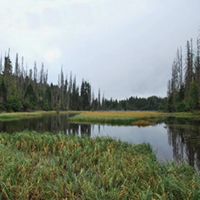Complex effects of acidification, habitat properties and fish stock on littoral macroinvertebrate assemblages in montane standing waters

Submitted: 6 August 2021
Accepted: 6 December 2021
Published: 11 January 2022
Accepted: 6 December 2021
Abstract Views: 4373
PDF: 363
Supplementary: 208
HTML: 120
Supplementary: 208
HTML: 120
Publisher's note
All claims expressed in this article are solely those of the authors and do not necessarily represent those of their affiliated organizations, or those of the publisher, the editors and the reviewers. Any product that may be evaluated in this article or claim that may be made by its manufacturer is not guaranteed or endorsed by the publisher.
All claims expressed in this article are solely those of the authors and do not necessarily represent those of their affiliated organizations, or those of the publisher, the editors and the reviewers. Any product that may be evaluated in this article or claim that may be made by its manufacturer is not guaranteed or endorsed by the publisher.
Similar Articles
- Margarita Caballero, Alejandro Rodriguez, Gloria Vilaclara, Beatriz Ortega, Priyadarsi Roy, Socorro Lozano-García, Hydrochemistry, ostracods and diatoms in a deep, tropical, crater lake in Western Mexico , Journal of Limnology: Vol. 72 No. 3 (2013)
- Päivi Rinta, David Bastviken, Jos Schilder, Maarten van Hardenbroek, Tabea Stötter, Oliver Heiri, Higher late summer methane emission from central than northern European lakes , Journal of Limnology: Vol. 76 No. 1 (2017)
- Cecilia Laprida, Maria S. Plastani, Alicia Irurzún, Claudia Gogorza, Ana M. Navas, Blas Valero-Garcés, Ana M. Sinito, Mid-late Holocene lake levels and trophic states of a shallow lake from the southern Pampa plain, Argentina , Journal of Limnology: Vol. 73 No. 2 (2014)
- Lisa Elzi, Edoardo Villa, Nicola Patocchi, Correlation between Phragmites australis growth and seasonal lake level variations in Lake Maggiore (Italy/Switzerland): common reed management guidelines , Journal of Limnology: Vol. 81 No. s2 (2022): Effects of water level management on lake littorals and downstream river areas
- Martin Čech, Lukáš Vejřík, Jiří Peterka, Milan Říha, Milan Muška, Tomáš Jůza, Vladislav Draštík, Michal Kratochvíl, Jan Kubečka, The use of artificial spawning substrates in order to understand the factors influencing the spawning site selection, depth of egg strands deposition and hatching time of perch (Perca fluviatilis L.) , Journal of Limnology: Vol. 71 No. 1 (2012)
- Mattia M. Azzella, Rossano Bolpagni, Alessandro Oggioni, A preliminary evaluation of lake morphometric traits influence on the maximum growing depth of macrophytes , Journal of Limnology: Vol. 73 No. 2 (2014)
- Maria Belen Sathicq, Tomasa Sbaffi, Giulia Borgomaneiro, Andrea Di Cesare, Raffaella Sabatino, The meiofauna as neglected carriers of antibiotic resistant and pathogenic bacteria in freshwater ecosystems , Journal of Limnology: Vol. 80 No. 3 (2021): Celebratory Issue - 80th Anniversary of the Journal of Limnology
- Andrea Gallorini, Jean-Luc Loizeau, Mercury methylation in oxic aquatic macro-environments: a review , Journal of Limnology: Vol. 80 No. 2 (2021)
- Javier Alcocer, William M. Lewis Jr., María del Carmen Hernández, Luis A. Oseguera, Vania J.J. Pérez, Narcís Prat, Habitat expansion of a tropical chironomid by seasonal alternation in use of littoral and profundal zones , Journal of Limnology: Vol. 81 (2022)
- Jordi Prats, Marie-José Salençon, Magali Gant, Pierre-Alain Danis, Simulation of the hydrodynamic behaviour of a Mediterranean reservoir under different climate change and management scenarios , Journal of Limnology: Vol. 77 No. 1 (2018)
<< < 6 7 8 9 10 11 12 13 14 15 > >>
You may also start an advanced similarity search for this article.

 https://doi.org/10.4081/jlimnol.2022.2053
https://doi.org/10.4081/jlimnol.2022.2053






